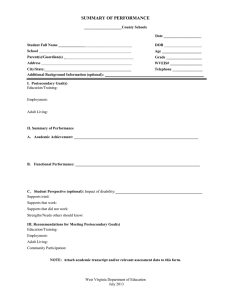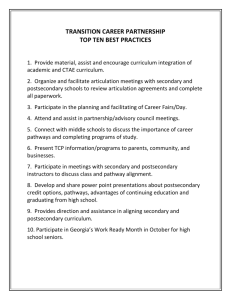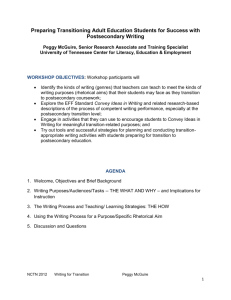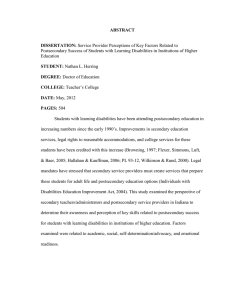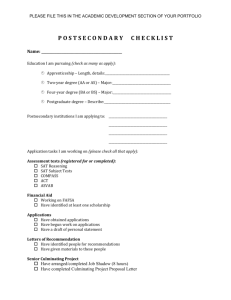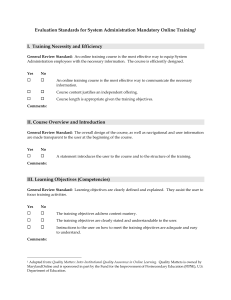A U ssessment
advertisement
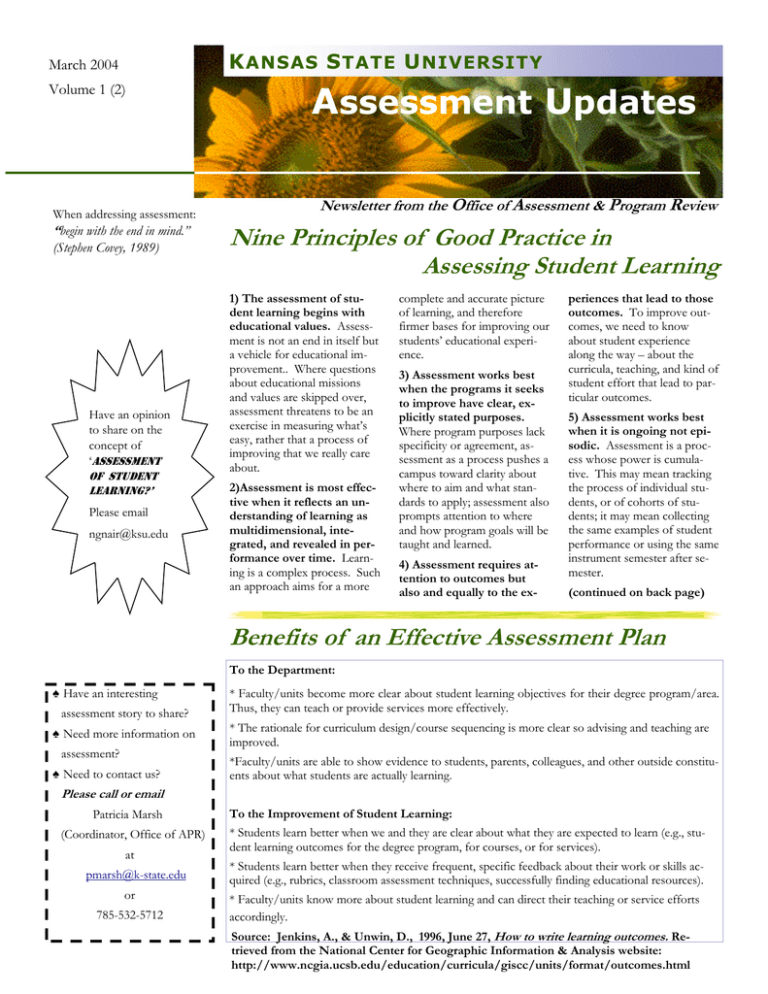
K ANSAS S TATE U NIVERSITY March 2004 Volume 1 (2) When addressing assessment: “begin with the end in mind.” (Stephen Covey, 1989) Have an opinion to share on the concept of ‘ASSESSMENT OF STUDENT LEARNING?’ Please email ngnair@ksu.edu Assessment Updates Newsletter from the Office of Assessment & Program Review Nine Principles of Good Practice in Assessing Student Learning 1) The assessment of student learning begins with educational values. Assessment is not an end in itself but a vehicle for educational improvement.. Where questions about educational missions and values are skipped over, assessment threatens to be an exercise in measuring what’s easy, rather that a process of improving that we really care about. 2)Assessment is most effective when it reflects an understanding of learning as multidimensional, integrated, and revealed in performance over time. Learning is a complex process. Such an approach aims for a more complete and accurate picture of learning, and therefore firmer bases for improving our students’ educational experience. 3) Assessment works best when the programs it seeks to improve have clear, explicitly stated purposes. Where program purposes lack specificity or agreement, assessment as a process pushes a campus toward clarity about where to aim and what standards to apply; assessment also prompts attention to where and how program goals will be taught and learned. 4) Assessment requires attention to outcomes but also and equally to the ex- periences that lead to those outcomes. To improve outcomes, we need to know about student experience along the way – about the curricula, teaching, and kind of student effort that lead to particular outcomes. 5) Assessment works best when it is ongoing not episodic. Assessment is a process whose power is cumulative. This may mean tracking the process of individual students, or of cohorts of students; it may mean collecting the same examples of student performance or using the same instrument semester after semester. (continued on back page) Benefits of an Effective Assessment Plan To the Department: ♠ Have an interesting assessment story to share? ♠ Need more information on assessment? ♠ Need to contact us? * Faculty/units become more clear about student learning objectives for their degree program/area. Thus, they can teach or provide services more effectively. * The rationale for curriculum design/course sequencing is more clear so advising and teaching are improved. *Faculty/units are able to show evidence to students, parents, colleagues, and other outside constituents about what students are actually learning. Please call or email Patricia Marsh (Coordinator, Office of APR) at pmarsh@k-state.edu or 785-532-5712 To the Improvement of Student Learning: * Students learn better when we and they are clear about what they are expected to learn (e.g., student learning outcomes for the degree program, for courses, or for services). * Students learn better when they receive frequent, specific feedback about their work or skills acquired (e.g., rubrics, classroom assessment techniques, successfully finding educational resources). * Faculty/units know more about student learning and can direct their teaching or service efforts accordingly. Source: Jenkins, A., & Unwin, D., 1996, June 27, How to write learning outcomes. Retrieved from the National Center for Geographic Information & Analysis website: http://www.ncgia.ucsb.edu/education/curricula/giscc/units/format/outcomes.html Assessment Updates Page 2 Volume 1 (2) 9 Principles of Good Practice … Expanding Your Assessment Vocabulary Assessment & Evaluation Assessment is the process of gathering , describing, and/or quantifying information about students’ performance. Performance can include knowledge, skills, and dispositions such as values and attitudes. Evaluation is the systematic process of determining the merit, value and worth of someone (the evaluee, such as a teacher, student, or employee) or something (the evaluant, such as a product, program, policy, procedure, or process). To learn more about NSoFaS: https://surveys.nces.ed.gov/ nsofas2004/ 6) Assessment fosters wider improvement when representatives from across the educational community are involved. Faculty play an especially important role, but assessment’s questions can’t be fully addressed without participation by student-affairs educators, librarians, administrators, and students. Assessment also involves individuals beyond the campus (alumni/ae, trustees, employers) whose experience can enrich the sense of appropriate aims and standards for learning. 7) Assessment makes a difference when it begins with issues of use and illuminates questions that people really care about. This implies assessment approaches that produce evidence that relevant parties will find credible, suggestive, and applicable to decisions that need to be made. 8) Assessment is most likely to lead to improvement when it is part of a larger set of conditions that promote change. Its greatest contribution comes on campuses where the quality of teaching and learning is visibly valued and worked at. On such campuses, the push to improve educational performance is a visible and primary goal of leadership; improving the quality of undergraduate education is central to the institution’s planning, budgeting, and personnel decisions. 9) Through assessment, educators meet responsibilities to students and to the public. That responsibility (from page 1) goes beyond the reporting of such information; our deeper obligation – to ourselves, our students, and society – is to improve. Those to whom educators are accountable have a corresponding obligation to support such attempts at improvement. Source: Alexander W. Astin; Trudy W. Banta; K. Patricia Cross; Elaine El-Khawas; Peter T. Ewell; Pat Hutchings; Theodore J. Marchese; Kay m. McClenney; Marica Mentkowski; Margaret A. Miller; E. Thomas Moran; Barbara D. Wright; American Association for Higher Education (AAHE) Assessment Forum, 1992 http://www.aahe.org/ assessment/assess_links.htm KSU in the 2004 National Study of Faculty/Students Kansas State University has been selected to participate in the 2004 National Study of Faculty and Students (NsoFaS). This study is being conducted by the National Center for Education Statistics (NCES), U.S. Department of Education, under contract by RTI International (RTI), a non-profit research organization. It combines two major studies, the National Study of Postsecondary Faculty (NSOPF) and the National Postsecondary Student Aid Study (NPSAS). The NSOPF (Faculty) includes a nationally representative sample of full-time and part-time faculty and instructional staff at public and private institutions in the United States. Information obtained from NSOPF can answer important research & policy questions about postsecondary education, such as the following: * How many full- and part-time faculty and instructional staff are there? * What are their background characteristics? * What are their workloads, and how much time is allocated to classroom instruction and other activities? * What are the current teaching practices and uses of technology among postsecondary faculty instructional staff? * What retirement packages are available to faculty and instructional staff? The NPSAS (Student) is a large nationally representative survey of undergraduate and graduate students, with a special focus on how they finance their education at different types of institutions and the characteristics of both aided and nonaided students and their families. Information obtained from NPSAS can answer important questions about financial aid, loan & grant policies for postsecondary education, such as the following: * What is the “net price” of education to the student and family? * How is student “need” for financial aid being met? * How much are students borrowing? * What are the characteristics of students beginning their postsecondary education in 2004, and how many of them persist in postsecondary education? A representative sample of faculty (n=57) have been contacted. A K-State representative group of students (n=109) will be sampled this March and April.
